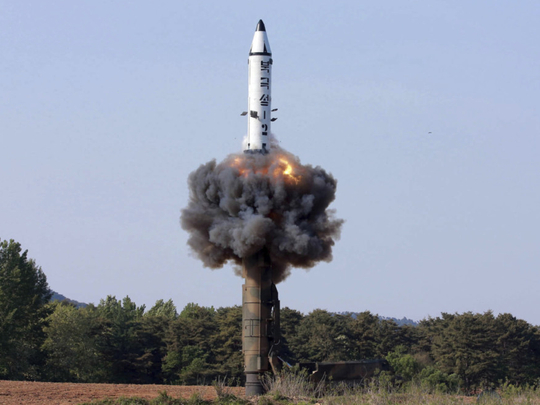
North Korea said yesterday that it was examining operational plans for attacking Guam, an angry reaction to new UN sanctions for its intercontinental ballistic missile tests and a US suggestion about preparations for possible preventive attacks to stop the North’s nuclear weapons programme.
While it’s extremely unlikely that North Korea’s leadership would risk its own destruction with a pre-emptive attack on Guam, an American territory about 3,400km from the Korean Peninsula, analysts believe the North does have several missiles in its arsenal capable of reaching the Pacific island, which Pyongyang has regularly threatened because of its US military bases.
What’s much less certain, however, is whether the North’s missiles can inflict serious damage once they reach Guam. Those missiles have never been used in combat situations and have had relatively few test flights. It’s also unclear whether North Korea has mastered the technology needed to protect the missiles from extreme heat and pressure upon atmospheric re-entry so they can hit the intended target.
With those caveats, a look at some of the missiles possibly capable of reaching Guam:
___
HWASONG-12
North Korea’s army said its plans to create an “enveloping fire” in areas around Guam are based on the Hwasong-12, a new intermediate range missile the country successfully flight-tested for the first time in May. The liquid-fuel missile is designed to be fired from road mobile launchers and has been previously described by North Korea as built for attacking Alaska and Hawaii.
The North followed the May launch with two flight tests of its Hwasong-14 ICBM last month. Analysts said that a wide swath of the continental US, including LA and Chicago, could be within reach of those missiles, once perfected. The flight data from the May launch suggested Hwasong-12’s range was between 4,000 and 7,000km.
___
MUSUDAN
Analysts say the liquid-fuel Musudan missile’s potential 3,500-km range puts much of Asia and the Pacific within reach. North Korea experienced several failures before a successful flight test in June last year, after which the country’s leader, Kim Jong Un, declared that his nation had the “sure capability to attack in an overall and practical way the Americans in the Pacific operation theatre.”
Before last year’s launches, North Korea had never flight-tested a Musudan missile, although one was displayed during a 2010 military parade in Pyongyang.
___
PUKGUKSONG-2
A land-based variant of a submarine-launched missile currently under development, North Korea first successfully flight-tested this solid-fuel midrange missile in February. In May Kim declared the missiles ready for mass production after another successful test.
Analysts say the Pukguksong-2 advances North Korea’s weapons capabilities because missiles using solid propellants can be fired faster and more secretly than those using liquid fuel, which must be fuelled before launch and transported to a launch site using trucks that could be spotted by satellites. North Korea describes the Pukguksong-2 as a “medium-to-long range strategic missile,” the same term it uses for the intermediate range Hwasong-12, and some South Korean experts see the missile as potentially capable of reaching Guam. But South Korean defence officials said after the May launch that they estimated Pukguksong-2’s range to be around 2,000km, which would be enough to strike US bases in Japan but come short of reaching Guam.












